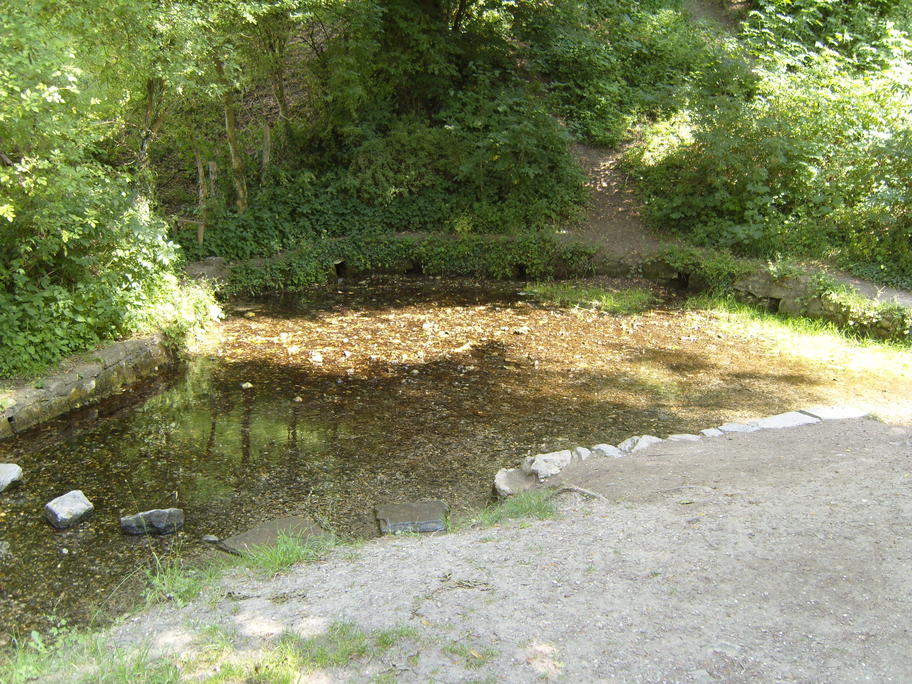|
|
 |
Seven wells
This article of mine appeared in Journal of the English Place-Name Society, 39, 7-44 (2007). The abstract follows:
At least one hundred instances of place-names apparently meaning "seven springs" or "seven streams" are known from England, France, Germany and elsewhere, whereas instances of any other numbers attached to similar water features are far less frequent. All current reference works interpret these names literally, leaving them "explained" but unmotivated. I will give evidence that the names belong to a continuous tradition starting from pre-Christian sacred springs with associated superstitions. Early Christianity first tried to suppress these superstitions, and when this failed, adopted the names with a new interpretation.
A pdf offprint is available here.
bibtex citation
@article{JEPNS-39-Briggs-Seven,
author={Keith Briggs},
title={Seven wells},
journal={Journal of the English Place-name Society},
volume={39}, pages={7--44}, year={2007}
}
Corrigenda
- Brian Rich has kindly pointed out that a more likely site for the Derbyshire Seuewelledale is at SK 231 579, about 500m north of Aldwark (not near Parwich as I had it). This was established by G. A. Makepeace in Derbyshire Archaeological Journal 121, 162
- In the gazetteer, the section for Somerset is out of alphabetical
order.
- In all displayed quotations, the source should be given before the
translation in square brackets, since the translation is mine, and not from the cited author.
Addenda
- 2014-07-15: Ann Cole informs me that in The valleys of the assassins and other Persian travels by Freya Stark, it is mentioned on page 277 of the Penguin edition that the author visited the “[...] valley of the Seven Springs, where the Chalus River begins in waterfalls.”.
- 2013-04-16: a district of Lisbon is called Sete Rios.
- 2012-01-09 another “seven wells”: unum rodam apud Seuewell' c.1260-70 in Maids Moreton (SP706351). G. R. Elvey (ed.), Luffield Priory charters part 2, page 252, no.592.
- 2010-02-03 two more French ones: Sept-fontaines (farm, St.-Tricat); Sept-fontaines (lieu-dit, Sangatte). In: Dictionnaire topographique de la France, comprenant les noms de lieux anciens et modernes: arrondissement de Boulogne-sur-Mer, M. l'abbé D. Haigneré, Vve C. Aigre, Boulogne-sur-Mer (1881).
- Another: Seaven wells 1694 in Lubenham. PN Leicestershire part 4, page 167.
- There is another instance of seven wells in OE charter bounds (making 5). I can't understand how I missed it in the article. It is in S694 (AD 961), a charter of King Edgar concerning land at Southstoke, Somerset. The charter text reads on þa ƿestran seofon ƿyllas (`to the westerly seven springs'). See S. Kelly, Charters of Bath and Wells (OUP 2007), number 14, page 115. The location is probably about ST 762 607.
- W. Borée, Die alten Ortsnamen Palästinas (Georg Olms Verlagsbuchhandlung, Hildesheim 1968) has Beersheba as "nicht die 7 Brunnen, sondern nur 'Brunnen der Sieben'" [not the 7 springs, but only "the springs of the seven"] (footnote, page 82)
- Concerning the frequency of numerals in place-names (pp. 8-9 of my article), Peter Kitson has counted
the occurrences in OE charter bounds in his article Quantifying qualifiers in Anglo-Saxon charter boundaries, Folia Linguistica Historica XIV/1-2, 29-82, (1993). He observes in his Table 4:
ān 185,
þrēo 43,
twēgen/twā 36,
seofon 20,
ǣnlīpig (`lone, single') 17,
fīf 15,
fēower 10,
twīg- 8,
þrittig 7,
twelf 5.
I think we can conclude that 7 occurs more often than expected.
- Some other classical references are
Septem Aquæ
and
Septem Maria.
(See, for example, W. Hazlitt Classical Gazetteer (London, 1851) and K. Miller Itineraria Romana (Strecker und Schröder, Stuttgart 1916)).
- Though it is not a watery example, it is interesting to note that the name of Ceuta (the Spanish enclave in Morocco), comes from Septem Fratres.
- Some say that Saba Biyar, recorded in classical times near the
Bitter Lakes in Egypt, means `seven wells'. See, for example, J. Wilson, The
lands of the Bible (Edinburgh 1847) vol. 1, page 139; and A. Calmet,
Dictionary of the Holy Bible (1832), page 465. This might be the same place as
the modern El Saba Abar in Ismailia.
- This passage from a letter of Alcuin (no. 262 in the MGH edition) is rather interesting, since it indicates that numerological thoughts on the number 7 were associated with the hot springs at Aachen ("David" is of course Charlemagne).
I suggest that the springs in question are those at Seffent.
Ad quod tantummodo magni pisces seligentur, qui, non scisso rete, apostolica
capti sunt praedicatione, erescente numero ab uno usque ad decem et septem
propter decalogum et septem sancti Spiritus dona. De cuius numeri mira
divisione et significatione olim me scripsisse memoro, dominoque meo David
dixisse, calido caritatis corde, in fervente naturalis aquae balneo.
[For this will the great fish be chosen, which were caught in untorn nets by the preaching of the apostle, in number ranging from one to seventeen, being the commandments and the seven gifts of the holy spirit. Of this number I remember I wrote previously of the wonderful division and meaning, and spoke about it to my lord David from a warm loving heart, in the hot springs of the bath.]
- So is this, from the chronicle of Alberic de Trois-Fontaines under the year 795, following a mention of Karolus rex and Aquisgrani: Hanc extruxit in honore beate Virginis, fecit ibi balnea calida, aqua frigida temperata, vel potius reparavit, quia iam ibi erant; et palatium iuxta ecclesiam. Ipsam vero ecclesiam depingi fecit veteris et nove legis hystoriis, palatium vero septem liberalibus disciplinis et bellis Hispanicis. (MGH Scriptorum XXIII Hannover MDCCCLXXIV, page 718) [translation to come]
photo
This is one of the two main groups of springs at Seffent. Taken by me 2011-07-11.
 This website uses no cookies. This page was last modified 2024-01-21 10:57
by
This website uses no cookies. This page was last modified 2024-01-21 10:57
by  . .
|
|
 This website uses no cookies. This page was last modified 2024-01-21 10:57
by
This website uses no cookies. This page was last modified 2024-01-21 10:57
by